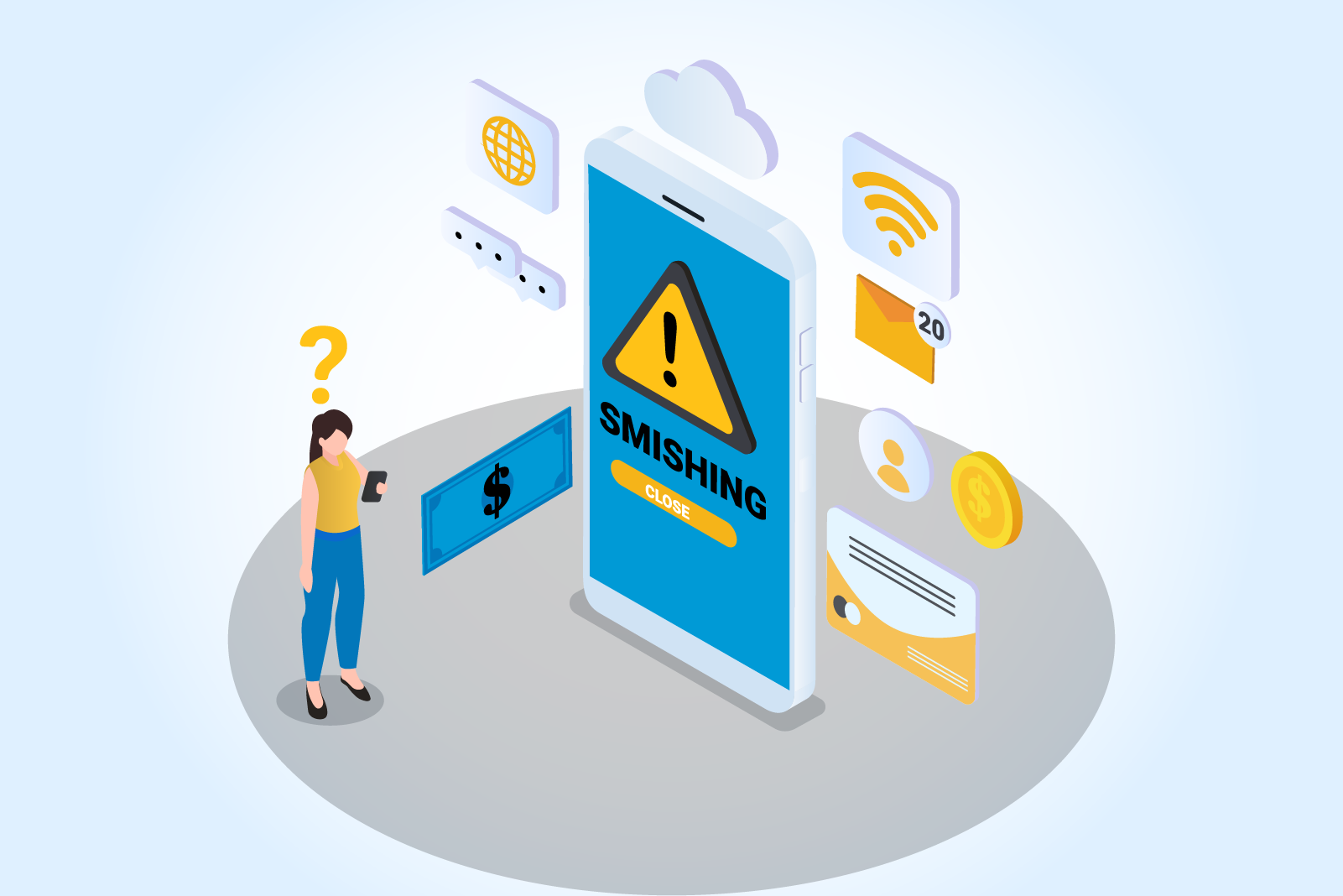Everyone hates spam. Whether it arrives via email, DM, or on that landline you kept in case of emergencies, it sparks a range of emotions from annoyance and anger to confusion and fear.
Spam is intrusive and a little scary, as it often has disingenuous intentions. And while everyone has had to develop certain technological skills, handling spam swiftly and smartly may not be among them.
It isn’t always easy to distinguish spam from legitimate communications. This prompts a number of questions, which include:
- Can you recognize spam?
- Do you know how to stop spam text messages?
- Do you know how to report spam text messages?
This post will cover how to manage whatever spam may come your way and review multiple spam text message examples so you can recognize suspicious messages instantly.
By the time you’re finished reading, you should have a solid understanding of what you can do to keep your personal information safe.
What Are Spam Text Messages Exactly?
Spam is a catch-all term used to refer to any sort of unsolicited, unwanted communication. It may arrive through:
- Phone calls
- Social media
- Text messages
Often, these calls and messages are sent in bulk. While some are geared toward persuading recipients to make a purchase and may be more irritating than hazardous, some spam is downright sinister.
What Are the Dangers of Spam?
Some spam calls and messages are either subtle or blatant phishing (or what’s now called “smishing”) scams — they act as a device to steal sensitive personal information, such as your:
- Personal identity details, like your Social Security number or home address.
- Online passwords.
- Credit card number.
- Bank account details.
Anyone with an email account or social media profile has probably experienced spam.
Alas, texting, perhaps the most common method of digital communication, has opened the floodgates for even more spam to pour in. It’s estimated that more than 10.89 billion spam text messages were sent in August of 2022 in the United States alone.
What Are the Repercussions of Falling for Spam?
Spam may seem like little more than a nuisance, but if the cybercriminals behind these communications are successful in their attempts, you may be vulnerable to:
- Identity theft.
- Viruses or malware.
- Hacked social media and other accounts.
Spam scammers are especially adept at getting through to their victims via text. They may employ an array of methods to ensure that their messages are delivered through phone carriers. These include:
- Email-to-text technology.
- “Spoofed” local numbers (most people are less likely to suspect that a particular message is spam if it arrives from an area code they recognize).
- Short codes.
Luckily, this may change in the near future. Many carriers, including AT&T and T-Mobile, are requiring businesses to switch to 10-digit long codes (10DLC) to send text messages. This requires a comprehensive verification process — plus a fee — with the aim of reducing unsolicited texts and decreasing fraud.
Is Spam Legal?
No, although the prevalence of spam texts may suggest otherwise.
In the past, businesses, organizations, political entities, and hackers could more or less send text messages freely in what became known as the “batch-and-blast” days, when spam communications were directed to massive audiences.
But public outcry prompted the Telephone Consumer Protection Act (TCPA) to include not just robocalls (remember them?) but also SMS and MMS messaging. Overseen by the Federal Communications Commission (FCC), the TCPA legally prohibits various entities from texting people without their explicit consent.
Why Are You Receiving Spam Text Messages?

If spam is illegal, why are you still getting so many unsolicited messages on your phone? The answer is surprisingly simple.
Many of us provide our phone numbers online, and scammers have the means to get hold of them through back channels like the databases of social media platforms.
How to Spot Spam Text Messages
Fortunately, there are several ways to shield yourself from spam text messages and deal with them head-on. That means it’s possible to minimize the number of unwanted messages you receive and safeguard your personal information.
First and foremost, you must know how to spot spam text messages in the first place.
Sometimes, spam texts are obvious — they make outrageous claims, the grammar and punctuation are noticeably off, and the content itself is unnecessarily urgent and suspicious. Other times, they’re much sneakier.
Need a spam text message example? We have 10 for you.
10 Spam Text Examples
We recommend reviewing the following examples closely so you can identify unsolicited communication instantly and take the necessary steps to protect yourself and others.
1. The “Your Family Needs Help” Text
Most people are painfully familiar with messages requesting assistance for a family member; these sorts of ruses flooded email inboxes in the early 2000s. Unfortunately, the long-running scam has leaked over to text. It may look something like this:
“Your niece has been arrested and needs $7,500.”
This is a particularly malicious form of phishing, as it plays into people’s vulnerabilities and prompts impulsive actions. If you receive a message of this kind, refrain from replying and instead contact your relatives for verification.
2. The “Congratulations” Text
Any message from an unverified sender that includes the word “congratulations” should be considered suspect.
While these messages can be alluring (who wouldn’t want to win something?), it’s important not to take the bait. Scam artists often exploit the excitement their recipients feel to get them to give up their financial info.
3. The “Package Delivery” Text
Spam senders occasionally use well-known, reputable names, like FedEx and USPS, to “alert” you of a package delivery. These texts typically have a “tracking link” attached, which cybercriminals will use to try to obtain key personal information.
Never open a link on any message that seems dubious. If you’ve ordered any items recently, track them through the confirmation email or text receipt you received from the retailer.
4. The “IRS” Text
Some particularly brazen scammers also use government names as part of their strategies.
For example, you might receive a message from the IRS stating that you have an unclaimed return and must provide your bank account details to receive your money. It should go without saying that these messages need to be handled carefully.
5. The “Job Offer” Text
If you’ve posted your resume on a job search site like Indeed or LinkedIn, you could receive a text that sounds legitimate at a glance:
“Hi, this is Cynde from HR. We have a couple question regarding your application. Please call [number] to schedule a interview.”
Notice the grammatical errors? Spam texts are notorious for their poor writing, while representatives of legitimate businesses will rarely make grammar, punctuation, or spelling mistakes in official communications.
6. The “Verify Your Account” Text
Another spam text message example is the ubiquitous “verify or update your account” message.
These texts can dupe even the most vigilant recipient, as they often include the names of companies whose products people rely on to conduct professional and personal business, such as Google or Apple:
“We’ve detected suspicious activity on your Google account. Follow this link to reset your password: [link].”
The trick to spotting these messages is to examine the link itself, which will typically be short, unintelligible, and not at all legitimate-looking.
7. The “Free Coupon” Text
If a scam artist has obtained your phone number, they may also have identified the brands you do business with and sent you a “free coupon” text under the guise of one of these companies.
Pause and read through these messages carefully. The voice and tone they employ will probably be completely different from the brand’s characteristic language. Moreover, a spam text will arrive from a number different from the one you have if you’ve subscribed to a brand’s SMS marketing.
8. The “New Service” Text
Scam artists fronting as businesses may text you about a new service and offer you a discount for signing up. Don’t be fooled, though — these services will likely have little relevance to you as a customer, nor will the message arrive from a trusted number.
9. The “New Billing Statement” Text
You may receive a text from a brand you trust, such as Amazon, alerting you to a new billing statement. Such texts frequently include a link directing you to “view your statement.”
If it’s a company you’ve done business with before, log into your official account to view your transactions and contact customer service if needed. Under no circumstances should you click the provided link.
10. The “Cryptocurrency” Text
Generally speaking, it’s wise to treat any text offering something for free with caution. Such texts might appear as follows:
“You received 3.41 Bitcoin (BTC). To confirm your transaction, visit [link] NOW.”
As with other suspicious communications, you should regard these messages skeptically and report them right away.
How to Report Spam
If you’re wondering how to report spam text messages, you might be surprised to learn that it’s simpler than you may have thought. You have a couple of options:
- Forward the spam text message to 7726 (SPAM). The Global System designated this number for Mobile Communications (GSMA) for suspicious messages.
- Report spam to the FCC by visiting their website and submitting a short form to their Consumer Inquiries and Complaint Center.
If a questionable text arrives from a company you do business with, call their customer service line to confirm that they haven’t tried to contact you and let them know you received a suspicious message that used their name.
How to Stop Spam Text Messages
Spam isn’t just disruptive — it can pose a genuine safety threat. To protect yourself, consider installing a spam-filtering app, such as Robokiller, SMS Blocker for iPhone, or Nomorobo. You can also register your phone number with the National Do Not Call Registry, which is easy and costs nothing.
Block any number that sends you spam. Doing so only takes a few seconds and could spare you a good deal of aggravation or misfortune.
Key Takeaways
Phone service providers have reported that spam text messages are on the rise. And while these carriers and other companies are implementing changes to cut down on fraudulent activity, such as 10DLC registration, scammers are famous for innovating new and harder-to-evade tactics.
Implementing these tips on how to recognize spam, how to report spam text messages, and how to stop spam text messages will give you a chance to fight back and avoid stepping into a digital trap.
Keep Your SMS and MMS Marketing Clean and Spam-Free with Contact Consumers
No reputable brand wants consumers to associate their name with spam. As one of the top SMS and MMS marketing platforms at work today, Contact Consumers takes the proper precautions to ensure that texts submitted on your behalf follow SMS best practices to enhance — not destroy — your reputation.
Explore our services today to take advantage of legitimate text messaging initiatives.




